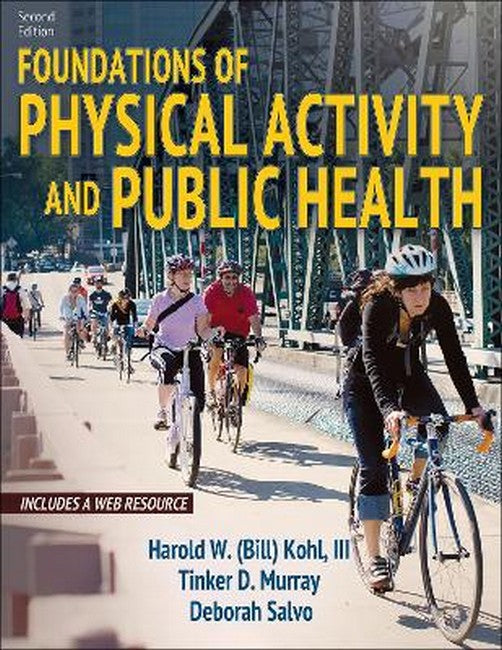Harold (Bill) Kohl III is a professor of epidemiology and exercise science at the University of Texas. Before this, he worked as the lead epidemiologist at the Centres for Disease Control and Prevention in Atlanta. Kohl has worked in the area of physical activity and health since 1984, this has including conducting research, developing intervention programmes and advising on policy issues. Kohl's other areas of specialisation are biostatistics and health promotion. ;;Tinker Murray is a professor of health and human performance at Texas State University. His research interests include school-based and clinical-based youth physical activity interventions for the prevention of obesity and diabetes, coach education and personal fitness and training applications relating to exercise physiology. Since 1984, he has been at Southwest Texas and Texas State University, where he has served as both the director of employee wellness and the director of the exercise performance laboratory. ;;Deborah Salvo is an assistant professor of epidemiology at the University of Texas.
Request Academic Copy
Please copy the ISBN for submitting review copy form
Description
Part I. Introduction to Physical Activity and Public Health Chapter 1. Fundamentals of Public Health Defining Moments in Public Health Areas of Specialization in Public Health Core Functions of Public Health Public Health Law Chapter 2. Fundamentals of Kinesiology Kinesiology Subdisciplines and Exercise Training Principles of Exercise Training, Prescription, and Planning Applying Physical Activity and Exercise Training Principles Health and Fitness Benefits of Physical Activity and Exercise Chapter 3. Integrating Public Health and Physical Activity History of Physical Activity and Public Health Role of Physical Activity in Chronic Disease Development From Science to Practice and Back Promoting Physical Activity for Health Practitioners of Physical Activity in Public Health Chapter 4. Measuring Physical Activity Evidence-Based Recommended Levels of Physical Activity for Health Laboratory Measures of Energy Expenditure Electronic Devices to Measure Physical Activity Direct Observation Techniques Self-Report Instruments Surveillance in Populations Combining Measurement Approaches Part II. Health Effects of Exercise and Physical Activity Chapter 5. Cardiorespiratory and Metabolic Health Prevalence of Cardiovascular Disease Risk Factors for Cardiovascular Disease Kinesiology and Cardiorespiratory Health Cardiorespiratory Fitness Assessments General Recommendations for Cardiorespiratory Health Prevalence and Economic Costs of Metabolic Disease Metabolic Disease Risk Factors Kinesiology and Metabolic Health Common Tests of Metabolic Function General Recommendations for Metabolic Health Chapter 6. Overweight and Obesity Caloric Balance Prevalence of Obesity and Overweight and Associated Health Consequences Obesity and Overweight Risk Factors Obesity and Overweight Challenges Kinesiology and Body Weight Common Assessments of Obesity and Overweight Physical Activity Guidelines for a Healthy Weight Chapter 7. Musculoskeletal and Functional Health Prevalence of Musculoskeletal Disorders and Related Health Challenges Risk Factors Associated With Musculoskeletal Disorders and Associated Health Challenges Kinesiology and Musculoskeletal Health Common Tests of Musculoskeletal Fitness or Function Physical Activity and Musculoskeletal Health Functional Health Risk Factors for Poor Functional Health Common Tests of Functional Health Fitness Recommendations for Functional Health Chapter 8. Cancers Prevalence of Cancers Cancer Risk Factors Kinesiology and Cancers Physical Activity Among Cancer Survivors Physical Activity Guidelines for Cancer Prevention Chapter 9. Brain Health Prevalence and Economic Costs of Brain Health Disorders Common Brain Health Conditions Risk Factors Associated With Brain Health Disorders Physical Activity and Brain Health Physical Activity and Brain Cognitive Function Physical Activity Guidelines for Brain Health Chapter 10. Health Risks of Exercise and Physical Activity Musculoskeletal Injuries Kinesiology and Musculoskeletal Injuries Sudden Adverse Cardiac Events Part III. Strategies for Effective Physical Activity Promotion Chapter 11. Informational Approaches for Promoting Physical Activity Understanding the Community Guide Rationale for Informational Approaches Chapter 12. School-Based Approaches to Promoting Physical Activity Rationale for School-Based Physical Activity Programs Kinesiology and Physical Activity Outcomes for Youth School-Based Physical Activity and Physical Fitness Assessments of Youth Physical Activity in Children and Adolescents International and National Trends in Youth Physical Activity Levels School-Based Physical Education Developmental Considerations for Physical Activity in Youth Chapter 13. Behavioral and Social Approaches to Understanding and Promoting Physical Activity Behavioral Theories and Theoretical Models of Behavior Change Social Support for Health Behavior Change Individually Adapted Health Behavior Change Programs Socio-Ecological Model of Behavior Social Support Interventions in Community Settings Chapter 14. Environmental and Policy Approaches to Promoting Physical Activity Access Urban Design Measuring the Built Environment Physical Activity Policy Land Use Policy Co-Benefits of Activity-Promoting Environments and Policies Chapter 15. Program and Policy Evaluation for Physical Activity and Public Health Ways to Measure Program and Policy Effectiveness Logic Models for Physical Activity Promotion and Policies Evaluation Designs Data Collection and Analysis Publishing and Communicating Results Chapter 16. Partnership Development and Advocacy Key Factors in Building Partnerships Strategies for Physical Activity Advocacy

